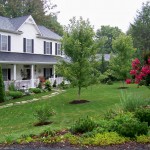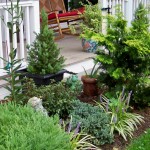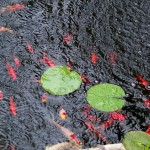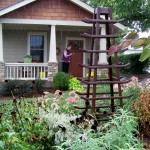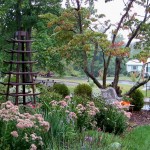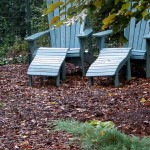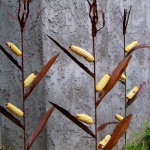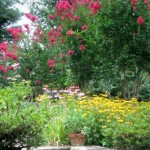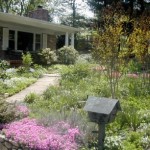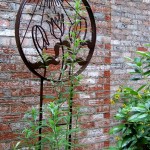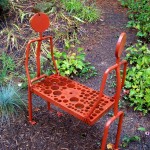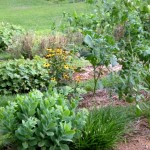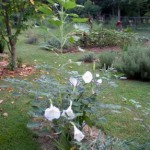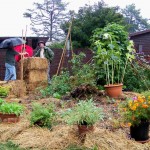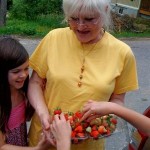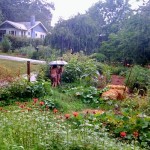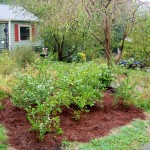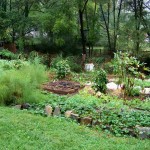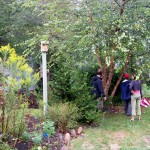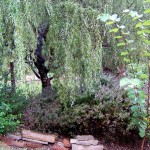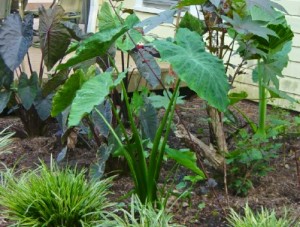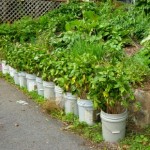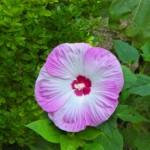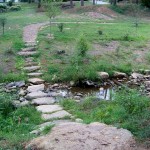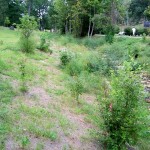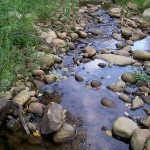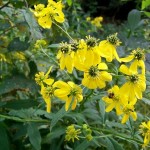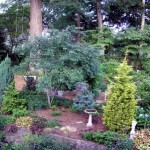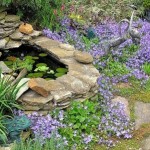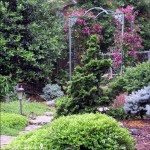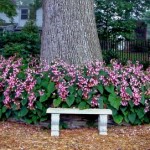In four short years, but spending a lot of time in their garden, Richard and Wanda Baird have planted hundreds of bulbs, many diverse perennials, daylilies, and many varieties of the hostas. In their backyard, they enjoy a large koi pond with a hundred koi and a variety of water plants to keep them company. Early spring, when bulbs begin to sprout, brings the greatest joy to the Bairds. “Almost weekly, the colors change as the different plants come into bloom causing many compliments from passers-by. ‘Oh, I know where the Baird’s live, on Sulphur Springs…where all the beautiful flowers are!’”
Author Archives: Christopher
2010-05 – VAL’S JOY
In 2009 Val and David Kula began to transform what had been an overgrown rental into their West Asheville home. Redoing the entire house and adding an addition was followed by bulldozing weedy lawns to make a clean slate (and to tame overgrown bamboo) so Val could make the garden of her dreams. She poured over pictures, gathered memories of trees and shrubs she loved, and began to sketch out a vision. With help from B.B. Barnes’ Hunter Stubbs, this vision has unfolded. A longtime friend, Linda, an avid and creative gardener, also jumped in to help with perennials. Now say the Kulas,“We especially love stepping out and cutting various herbs for our meals and have so enjoyed eating dinners on the screened porch overlooking our beautiful and peaceful oasis.”
2010 – 06 – THE BLAU GARDEN
A few years back Amy & Eric Blau tilled up their entire front yard and planted a row of crape myrtles, Korean spice viburnum and American beauty bush. Now their garden includes native spring ephemerals such as jack-in-the-pulpit, trillium and Solomon’s seal. For summer color, they have planted a wide variety of daylilies and other lilies which are Amy’s favorites. Amy has also cultivated a few self-pollinating fruit trees, including cherry and peach, and built two raised beds for strawberries and blueberries. “I also plant castor beans every year which came from my granddad’s seed stock over 30 years ago.” Also, check out the tree house in the back yard built with a girlfriend for their kids, using wood recycled from an old deck.
2010-07 – JUDITH’S GARDEN
Judith Beers’ backyard receives a lot of sun and it was perfect for an edible (and organic) garden. Removing the lawn, she installed raised beds which she filled with an eclectic mix of plants in her attempt to be more self-sufficient. She dug beds for herbs and bulbs, and over the years added fruit trees, berries, asparagus, perennial flowers, as well as annually planted vegetable and flower starts. Judith says her garden responds to her intention to “have beauty around me, experiment, and feed my soul.” She adds, “ Come visit!”
2010 – 08 – GOOD EARTH ORGANICS GARDEN
This garden was started end of May, 2010, as a demonstration project to show part of the process of converting lawn to gardens. Specifically, Jim Smith used sheet-mulching (aka lasagna gardening), where layering of cardboard, newspaper and straw and/or alfalfa hay initiates a process of transformation. Visitors can see the difference this system made in just three months in before and after areas. In connection with this, Jim plans to discuss the ideas behind a soil biological process called the “soil food web” with anyone interested. He tells us, “I will also show how to integrate composting into a garden, give advice on the use of organic amendments, and offer ideas for inter-planting.” Note: Compost bins will also be for sale at this site.
2010-09 – FREEBORN’S FARM
In Bryan Freeborn and Bridgett O’Hara’s garden, kids pick and eat beans, berries, tomatoes and mint leaves and even catch bugs to feed their toads. It all began in 2004 by ripping up the grass and planting sunflowers in the front yard which attracted tiny yellow gold finches and squirrels to feast. On the South side of the yard, small raised beds grow greens, veggies, and strawberries. Abundant hops, raspberries and wine berries line the sunny fence row. On the North side, native paw-paw trees and an elderberry flourish. “Our garden is not the Martha Stewart, fancy garden from a magazine. We enjoy growing it and playing in it. During the Stroll, enjoy a kid-run lemonade-with-a-twist stand and free paw-paw seeds while they last.”
2010-10 – C and W GARDEN
According to Claire Fontana and Wylie Paxton, “Our garden is a transitional space from non-native perennial shrubs and herbs to typical natives and their respective habitats co-occurring on the property.” Sited on the North side of the Salola Street/Carrier Street ridge, the Paxtons grow many fruits: raspberries, paw-paw, persimmon, plum, quince, and muscadine grapes. For vegetables, they have developed raised beds, a cold frame site, and a kitchen garden. North slope natives are also well represented with black cohosh, white wood aster, green headed coneflower, Turks cap lily, cardinal flower, bleeding heart, and many Spring ephemerals. The space that used to be lawn now grows prairie plants such as big bluestem, little bluestem, false indigo, bee-balm, several coreopsis species, Stokes aster, swamp milkweed and purple coneflower.
2010-11 – RUMBOUGH PLACE VEGETABLE AND RESCUE GARDEN
At Jimmy Burns and Johanna Finkelstein Vegetable and Rescue Garden, ornamentals are slowly changing away from a mix of plants salvaged from the mark down racks and dumpsters of what they call “cruel big box retailers.” (Jimmy muses, “Did we really need 720 pansies last year?”) Different beds demonstrate their varying degrees of success with no-till, low-till and cover crop garden methods. Vegetable beds contain root crops for late harvest/storage and the last of the summer veggies mixed with the fall planting of greens. Elsewhere, beds are being prepared for next year’s fruit and berry plants. (Jimmy added, “Fellow gardeners, share your fruit and berry stories and help us decide what to plant.”) Note: Rescued plants ranging from herbs to azaleas are available for very modest adoption fees. “No background check required.”
2010-12 – BUTTERMILK CREEK RESTORATION IN MALVERN HILLS PARK – Rumbough Place
In 2008, RiverLink teamed with Baker Engineering to develop and implement a stream restoration and stormwater mitigation project. Covering approximately 1100 linear feet of stream restoration and employing stormwater best management practices, the project reduces sedimentation and improves water quality in Buttermilk Creek and the larger system of Hominy Creek and the French Broad River which it feeds. The project also provides connection to Hominy Creek Greenway and the Wilma Dykeman RiverWay. Neighborhood volunteers helped with the plantings, removing invasive plant species and setting in live stakes. Look for soft rush,big bluestem, nine bark, and silky dogwood. The Clean Water Management Trust Fund provided grant funding for this project along with additional matching funds.
As a collaborative effort to keep West Asheville’s creeks clean, the City of Asheville, Riverlink and community volunteers will continue this work by planting, mulching and creating a new walking trail within the park. And during this year’s Garden Stroll, Higgins Horticulture and several volunteers will be working to amintain and mulch the planting along Buttermilk Creek. Please feel free to come by and lend a hand.
2010-13 – THE BEAR CREEK GARDEN
Norbert Artzt and John Denton’s Bear Creek Garden is a 1/3 acre, plant sanctuary that surrounds a modest 1946 red brick cottage. Begun in 1996, it contains a rich collection of both sun- and shade-loving native plants as well as conifers, woody evergreens, flowering shrubs, perennials and vines, camellias, ferns, and lilies. Over 300 different species fill the densely textured, mixed beds. Both formally shaped and naturalized elements combine to produce stasis and movement and a good measure of beauty in all seasons. Norbert notes, “The overall design, though essentially simple, draws the garden visitor along widening and narrowing pathways from one area to another. Dominating the woodland landscape is a magnificent, centuries-old white oak tree, one of the finest in the city.” Note: There is no parking on Bear Creek, please park at St. George’s Episcopal Church and walk to this garden. The sidewalk is on the other side of the street; please be careful when crossing the street.

